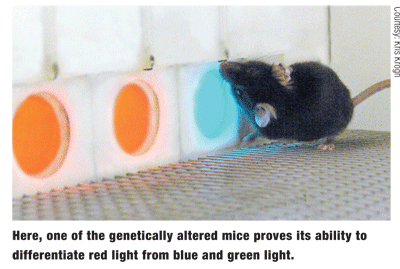A group of mice have been given the ability to see a whole new world of color by researchers from the
Mice are dichromats that only possess short- and medium-wavelength-sensitive cones. They dont see red light; they only see blue and green light, similar to a person with red-green color blindness. The researchers took human long wavelength-sensitive cones, which enable reception of red light waves, and inserted them into the retinas of mouse embryos.

Researchers found that the brains of the mice immediately incorporated the upgrade and efficiently processed the additional sensory information; they were able to distinguish among a broader spectrum of light waves. They tested the rodents comprehension of the new wavelengths by training them to select one differently colored panel out of three.The altered mice selected the correct panel 80% of the time, while unaltered mice only chose the correct panel one-third of the time.
These findings may help explain the evolution of color vision and color blindness. What we are looking at in these mice is the same evolutionary event that happened in one of the distant ancestors of all primates and that led ultimately to the trichromatic color vision that we now enjoy, the researchers say. These findings may also play a role in understanding the evolution of other senses, such as smell and taste, they add.
Jacobs GH, Williams GA, Cahill H, Nathans J. Emergence of novel color vision in mice engineered to express a human cone photopigment. Science 2007 Mar 23;315(5819):1723-5.

